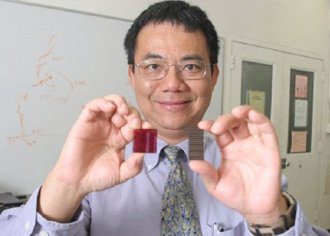Yang Yang Sets Record for Polymer Solar Cell Efficiency
UCLA professor Yang Yang has set a new efficiency record for polymer solar cells, breaking his own group's earlier record.
UCLA professor Yang Yang has set a new efficiency record for polymer solar cells by converting 10.6% of the energy of sunlight into electricity. The new efficiency level surpasses the prior record of 8.6% set by his group last July.
The goal of Yang’s research group is to achieve 15% efficiency. Because efficiency drops by about a third when solar cells make the transition from the lab to commercial production, a polymer cell that attains 15% efficiency in his lab would ultimately become a module with 10% efficiency. At that level it would be good enough to compete with thin-film silicon photovoltaic cells, Yang figures.
The advantage of polymer — or plastic — solar cells is their flexibility, light weight and the promise of cost efficiency once the right chemistry has been achieved. At the moment, however, they remain about 50-80% less efficient than conventional cells made of silicon or other inorganic materials.
Yang was able to develop his latest record-breaking polymer cell by using a new photovoltaic polymer developed by Sumitomo Chemical. The new plastic solar cell combines two photovoltaic layers that tap two bands of the electromagnetic spectrum — visible light and infrared light — just as the most efficient inorganic solar cells do.
“The solar spectrum is very broad, from the near infrared through the infrared to the ultraviolet, and one single solar-cell component can’t do it all,” explained Yang.
What makes polymer cells potentially so cost-efficient is that they are created by applying solution onto the substrate just as ink is printed onto paper. The liquid solution dries at room temperature without the need for costly heat curing. The difficulty is in keeping one layer of polymer from bleeding into the other, and also in ensuring reliable electrical conductivity of each layer.
But the rewards can be great. Yang’s polymer photovoltaics can be applied to virtually any surface like paint to tap the solar energy hitting them. Examples would be large murals painted on the walls of warehouses or even freeway embankments using Yang’s polymers.
“Energy is everywhere, is surrounding us,” Yang has said of his interest in polymer solar cells. “It’s a matter of how can we recycle it and re-collect them and then use it.”
Yang Yang is a professor of materials science and engineering at UCLA’s Henry Samueli School of Engineering and Applied Science. Yang received his bachelor’s degree from National Cheng-Kung University in Taiwan. He has a master’s and a doctorate in physics and applied physics from the University of Massachusetts at Lowell. Yang worked at UC Riverside as a postdoctoral researcher and at UNIAX Corp. (now DuPont Displays) in Santa Barbara as a research staff member before joining the UCLA faculty in 1997.
Yang is also faculty director of the Nano Renewable Energy Center at the California NanoSystems Institute at UCLA and serves as director of the Center for Organic Opto-electronics Technologies at Zhejiang University in China. He is also the faculty adviser for the UCLA student branch of the Society for Information Display (SID).
Last July Yang was named the holder of the Carol and Lawrence E. Tannas Jr. Endowed Chair in Engineering, the first in the world dedicated to the area of electronic information displays.

UCLA materials science professor Yang Yang has achieved a new efficiency breakthrough with polymer solar cells.

